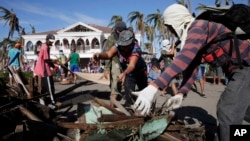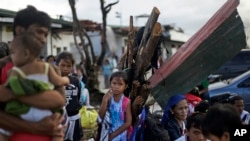MANILA —
As Philippines authorities continue to transition to the needs of long-term recovery of typhoon devastated areas, authorities are building temporary housing, expanding "cash for work" and "food for work" programs to clear debris, and looking at long-term measures like planting mangroves along vulnerable coastlines.
Officials say the worst-hit provinces of Leyte and Samar are showing signs of recovery. They note that banks are reopening, small markets are in business and in some places more than three quarters of the debris that clogged the streets has been removed. This has opened up roads to transportation services.
But Super Typhoon Haiyan obliterated and destroyed more than a million houses.
Presidential spokesman Sonny Coloma said providing housing is a priority.
“The transfer of affected families from tents and evacuation centers to temporary bunkhouses signals the transition from relief to early recovery and reconstruction,” Coloma said.
The Office of Civil Defense says 116 “bunkhouses” are in place in the hardest hit city of Tacloban in Leyte and five other nearby municipalities. These structures accommodate 24 families of five. And each building has a central kitchen and common restrooms with a medical facility on one end.
The government and several humanitarian agencies have implemented “cash for work” programs, which pay displaced residents a day rate to clear debris. Survivors are also working for food.
Civil Defense Executive Director Eduardo del Rosario said provincial governments are planning to invest in agriculture to help displaced residents become less dependent on relief operations. He said food aid will continue for as long as it is needed, adding that this will “interlock” with early recovery and early rehabilitation work.
“Our intention is to attain normalcy as early as possible. We could not say that it is 100 percent normal,” del Rosario said.
Philippine officials estimate the cost of rebuilding at $5.8 billion.
According to the Civil Defense office, 3.4 million people remain displaced more than two weeks after Typhoon Haiyan struck. The United Nations says it affected more than 13 million people.
The U.N. says not everyone has access to markets to replenish food stocks in the long-term. The agency also says supplies of emergency shelter provisions are running low and groups that had provided them initially are close to exhausting their funding to buy more.
Del Rosario said the government is requiring a 40 meter easement from the Tacloban coastline where squatters made their homes. The typhoon churned up a massive storm surge along the coast that killed scores of people in its wake.
“It will be planted with mangroves because per a study conducted, mangroves can decrease by 70 percent, [the] strength [of a] storm surge,” he explained.
Del Rosario said, while the government expects to see some of the foreign militaries that initially responded start to leave after 15-day relief stints, others continue to arrive. He said these later arrivals are focusing on medical relief and engineering help for rebuilding.
Officials say the worst-hit provinces of Leyte and Samar are showing signs of recovery. They note that banks are reopening, small markets are in business and in some places more than three quarters of the debris that clogged the streets has been removed. This has opened up roads to transportation services.
But Super Typhoon Haiyan obliterated and destroyed more than a million houses.
Presidential spokesman Sonny Coloma said providing housing is a priority.
“The transfer of affected families from tents and evacuation centers to temporary bunkhouses signals the transition from relief to early recovery and reconstruction,” Coloma said.
The Office of Civil Defense says 116 “bunkhouses” are in place in the hardest hit city of Tacloban in Leyte and five other nearby municipalities. These structures accommodate 24 families of five. And each building has a central kitchen and common restrooms with a medical facility on one end.
The government and several humanitarian agencies have implemented “cash for work” programs, which pay displaced residents a day rate to clear debris. Survivors are also working for food.
Civil Defense Executive Director Eduardo del Rosario said provincial governments are planning to invest in agriculture to help displaced residents become less dependent on relief operations. He said food aid will continue for as long as it is needed, adding that this will “interlock” with early recovery and early rehabilitation work.
“Our intention is to attain normalcy as early as possible. We could not say that it is 100 percent normal,” del Rosario said.
Philippine officials estimate the cost of rebuilding at $5.8 billion.
According to the Civil Defense office, 3.4 million people remain displaced more than two weeks after Typhoon Haiyan struck. The United Nations says it affected more than 13 million people.
The U.N. says not everyone has access to markets to replenish food stocks in the long-term. The agency also says supplies of emergency shelter provisions are running low and groups that had provided them initially are close to exhausting their funding to buy more.
Del Rosario said the government is requiring a 40 meter easement from the Tacloban coastline where squatters made their homes. The typhoon churned up a massive storm surge along the coast that killed scores of people in its wake.
“It will be planted with mangroves because per a study conducted, mangroves can decrease by 70 percent, [the] strength [of a] storm surge,” he explained.
Del Rosario said, while the government expects to see some of the foreign militaries that initially responded start to leave after 15-day relief stints, others continue to arrive. He said these later arrivals are focusing on medical relief and engineering help for rebuilding.













